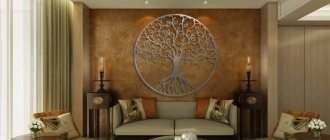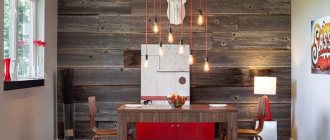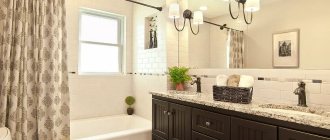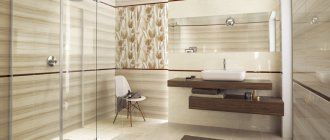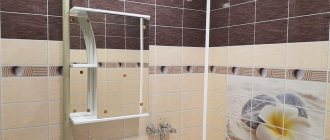Floral tiles
This design is perfect for finishing a bathroom floor. Entering the room, you might think that there is a flower field under your feet. The photo shows Candela tiles: one of the most beautiful creations of the Spanish company Peronda, a leading European manufacturer of ceramic tiles. The amazing pattern was made by designer Juan Vidal, who in turn borrowed the idea from the company that produces Tiffany table lamps.
Unusual tile design
As you know, if flowers grow somewhere, you can often see beautiful colorful butterflies among them. If they were gray, it wouldn't look as great...unless we're talking about the pattern on the surface of the ceramic floor tiles. Designer Ruben Toledo from the New York branch of Ceramica Bardelli presented the world with a wonderful collection called Papillon (French for “butterfly”).
Ceramic floor tiles from the Selection Floor collection from the world famous brand Ceramiche Supergres, based in the small Italian town of Casalgrande. Their tiles are known for a huge variety of designs and surface patterns that will look great on your living room floor.
Tiles diagonally on the floor, marking methods
Diagonal laying of tiles is considered the most difficult, so initially it is necessary to correctly mark the working surface. Diagonal installation of tiles can take place in 2 ways:
- From the center. To mark, it is enough to determine the center of the room. We stretch 2 straight lines from opposite corners of the room (you can use a special breaker). Or simply stretch the lace). The intersection of the lines is the center of the room, from which you need to start the layout.
- From the corner of the room. This option involves starting work from one of the corners of the room, as is clear from the name. Several squares of tiles are cut into triangles, and then they are first laid out on the floor without an adhesive mixture. After this “trying on” of the drawing, you can begin the main work.
Antique style tiles
The Eco Ceramica company offers an equally original design for floor tiles from the D'Autore collection, namely rough-hewn, old-fashioned stone: surprisingly, this finish looks very harmonious and makes a pleasant impression.
Moreover, there are options with tiles of different geometric shapes to choose from.
In the 14th century, floors in palaces and temples looked similar, and this is where the idea was taken from by modern designers, and we must admit that this experiment turned out to be more than successful. The tile collection called Maestri Ceramisti by Eco Ceramica was inspired by the luxurious and striking floors of Avignon, the then French residence of the popes. In addition to ten different colors, the assortment includes many interesting ornaments that can be combined with each other in any way you like, bringing the whole picture on the floor in any room to a unique and spectacular look.
Here, for example, is a photo of a bathroom where quite original tiles from the Rinascamento collection were used - another masterpiece from Eco Ceramica. It is made using the patchwork technique with an exquisite floral pattern, which is also made in an old-fashioned style.
Main news
Modern designs have little in common with older models, which are fragile, brittle and difficult to install. Manufacturers strive for environmental friendliness, efficiency and practicality. Ceramic tile designs become more aesthetically pleasing.
Increase in size
The area of the elements increases. This allows for quick installation. The masonry looks more aesthetically pleasing due to the reduction in the number of joints. This same feature allows you to save on putty. Fewer gaps save time on cleaning the surface.
Increasing the size makes it possible to use large, bold patterns in modern tile design without fear of spoiling the integrity of the picture.
Thickness reduction
The finishing material becomes thinner and lighter. This makes laying easier and increases service life.
Increased service life
This is an excellent material for cladding surfaces in places with high humidity and strong temperature changes. Modern models can easily withstand the most intense heat. They don't break when hit.
Variety of textures
Unusual textures have become popular. They are artificially “aged” by adding cracks. This material looks great in retro and classic designs. New this season are “velvet” samples that imitate velor fabric. Interesting specimens with a combined surface.
Non-standard forms
In addition to the usual squares or rectangles of “bricks”, this year designers are actively using types made in the form of hexagons “honeycombs”. Arabesque tiles have received a second wind. In the photo of new tile designs for 2022, you can even see such a bold solution as ceramics in the shape of fish scales.
Vintage tile style
Eco Ceramica, already well known to us, never ceases to amaze us with its ideas. Let's look at several vintage collections of the manufacturer. The La Ceramica d'Eccellenza tile series is intended only for bathroom floors: perfect for those who want to create an artistic or bohemian finish.
Interesting are the patchwork style tiles from the Le Civilta collection. This antique design will fit perfectly into the interior of both the bathroom and living room.
The La Sete Preziose series tiles also cannot be ignored: the light lilac shade of the floor will create a peaceful atmosphere in any room.
Another example of patchwork tiles from the Colori Naturali collection, but this time made in a modern manner, combining many bright colors and different patterns.
What is a ceramic surface?
This material is usually used from a functional point of view because of its individual positive qualities.
But as for the tiles in the living room, here their use is characterized exclusively from a decorative point of view. The main types of design include:
- leather options;
- imitation granite;
- resemblance to marble;
- animal skin.
It is such non-standard solutions, for example, in the form of mirror tiles in the living room, that can give your floor some individuality and set it apart from the overall interior.
Since special attention will be paid specifically to the flooring, it should be taken into account that the remaining details are purchased in neutral colors and shapes, this is shown in the photo of the tiles in the living room, so that the interior does not seem too overloaded.
Recently, designers are increasingly inclined to use so-called mosaic tiles on the living room floor.
On the wall it can be used in the form of a panel or painting; it can decorate all existing wall surfaces or just one.
Using tiles in the living room interior has its significant advantages:
- strength and durability of use;
- suitable for creating any style solution;
- helps create the necessary and varied visual effects.
Victorian style tiles
The Minoo series tiles from the Dutch interior design geniuses from the Marcel Wanders studio will undoubtedly give an elegant look to the bathroom floor surface. There are 5 different pattern types to choose from in this range, each available in eight shades.
A selection of several flooring options for a living room in a Victorian style from the Ornamenti collection from Eco Ceramica.
Material selection
There are both general rules that are suitable for choosing all types of tiles, and features that you should pay attention to when choosing a coating for a specific room.
General rules
- The edges of individual elements must be smooth and without chips.
- For walls, it is recommended to choose ceramics with a corrugated surface. It will provide good adhesion to the wall.
- For floors, ceramics with a non-slip coating are suitable.
- You should carefully read the symbols on the packaging. Manufacturers clearly indicate the moisture resistance of the material, strength and other indicators.
- When choosing glossy options, you should know that they visually make the room smaller. However, this coating is easier to clean. Matte ones are less easy to clean, but dirt on them is almost invisible.
- It is necessary to take the material with a reserve of at least +10%.
- For the bathroom. Ceramics for the bathroom should be moisture resistant and have maximum protection from chemicals. For a small room, you should not take wide-format options, since installing them, taking into account the large number of pipes in the bathroom, will be labor-intensive.
- For kitchen. Not only the design of the tiles in the kitchen is important, but also its physical characteristics. For the floor, it must be shockproof and abrasion resistant. For an apron, you need to choose a heat-resistant and easy-to-clean option. It is better to avoid items with a porous surface, as they absorb odors and are difficult to clean.
Miniature tiles
An amazing and truly unique floor design was created using small mosaic tiles from the same masters from Eco Ceramica.
Decorative "carpet" tiles
Porcelain “carpet” tiles of the Auris series from the Spanish company Peronda, engaged in the manufacture and design processing of ceramic products, can give a truly luxurious look to the floor in the living room.
The Italian version of “carpet tiles” with vintage painted patterns from Fap Ceramiche also cannot be ignored.
Original offset tile laying
Tiles are often used to decorate walls not only in apartments and private houses, but also in public places. To diversify the design of a room, a simple but at the same time original method of laying tiles with offset is often used.
For these purposes, rectangular tiles are used (square ones are less common). This type of tile laying is very similar to brickwork and is performed according to the same principle: the center of the tiles of the previous row is at the level of the junction of two elements of the next row.
This technique is perfect for the following rooms:
- Bath;
- kitchen;
- toilet;
- corridor/hallway.
The advantage of this technology is its versatility. In addition, by laying tiles offset, you can hide some surface defects (irregularities and bumps). You can diversify this styling by using some inserts with ornaments, or by combining several colors.
Installation of offset tiles is no different from classic masonry. It also requires the use of an adhesive mixture, crosses to control the seams, a spatula and a building level (to check the evenness of the installation).
For high-quality installation, it is recommended to apply a diagram of the placement of coating elements on the wall in advance. In other words, draw the location of the tiles. This will help you accurately calculate the amount of materials needed and not disturb the drawing during the work.
Hexagonal Floor Tile
Tiles of this shape will help to recreate the unique design of the floor surface in the room. Below is a stunning example of bathroom flooring. Blue tiles look very nice together with marine motif patterns. No less wonderful combinations are contained in the Lucia collection of hexagonal tiles from Italian ceramics experts from the Verso25 company.
The Peronda company offers some interesting ideas by releasing a range of hexagonal tiles called Argila Origine. The essence of this design is the use of two shades (blue and brown) and four relief patterns.
Below is a floor covered with hexagonal tiles made of multi-colored rough-hewn stones with many patterns: this Palatium collection is made by Eco Ceramica.
The list of unusual hexagonal tiles is completed by a more classic version from the La Galleria series, made by the same masters from Eco Ceramica.
How to lay tiles with your own hands, expert advice
Correct placement of tiles on the surface is the key to a beautiful and neat ornament. Different types of layouts have their own installation features. The following useful tips from professionals will help you get the job done as correctly as possible:
- Preliminary preparation, including leveling the surface and cleaning it from dust and dirt, is the main stage of high-quality tile laying.
- The adhesive mixture is selected depending on the temperature and humidity in the room where the work is planned to be carried out.
- For all layout methods, it is recommended to make preliminary markings on the floor.
- Beforehand, if a complex pattern is being made, it is recommended to cut the tiles and lay them on the floor without adhesive. This way you can immediately see what the final result will look like and “try out” the layout itself.
Important! For this preliminary layout, the tiles are laid on a fabric, and not on a bare floor.
- All complex technologies for installing patterned tiles must begin from the center of the room. Simple installation can be started from a corner.
- Treating the surface with liquid waterproofing will improve adhesion.
- If the floor has been treated with impregnation, it must be given time to dry before starting work.
- Grouting of joints takes place after the adhesive has completely dried.
Linen carpet
This technology is recommended for use in large rooms. It is considered a very sophisticated and unusual way to cover the floor. The principle of laying a “carpet” is that some kind of pattern is laid out of tiles in the center of the room, it is framed by elements of a different color and/or shape around the perimeter, and the last few rows of decoration are made of a plain background. The advantage of this technique is that the design can be selected individually to suit your interior, and there are no restrictions in this regard.
Kaleidoscope
Kaleidoscope is a bright and unusual design option for any room. This styling method allows you to experiment with patterns and come up with it yourself. Experts recommend thinking through the pattern in advance, otherwise it will simply get confusing and confusing in such a pattern.
To install tiles using this technology, it is necessary to perfectly level the surface, otherwise defects will immediately be evident.
Laying tiles diagonally
Before laying the tiles diagonally, it is necessary to make an accurate calculation of the pattern. First of all, the surface is prepared: the remnants of the old coating are removed, the surface is leveled, and after that you need to vacuum it to remove all excess debris.
For this layout method, the main thing is to start correctly. The first 4 tiles will do all the work: we determine the center of the room, lay the tile so that its corner is in the center of the room, and the sides go directly along the marking lines. Using the same principle, we lay the other 3 tiles. Then, starting from the center, we lay out the tiles in rows so that they go diagonally.
The process of laying tiles with a diamond shape with your own hands
The process of laying a diamond is practically no different from a diagonal one. Let's look at the detailed instructions:
- As in the previous method, we determine the center of the room, and lay the first tile at an angle to the center so that its sides lie directly on the diagonal of the marking.
- The adhesive mixture is applied with a notched trowel to the floor and to the back surface of the tiles. We apply the material to the floor.
- To get rid of voids, after the tile is in the correct position, you need to tap it a little with a rubber mallet so that the glue comes out slightly beyond the tile.
- We check the evenness of the installation using a building level.
- Next, we lay out a diagonal line (one row) to one corner of the room, and then return to the center and lay out the tiles to the other corner. After the first row has dried, we begin to lay out the second according to the same principle.
Diagonal tile laying with offset and inserts
Laying floor tiles offset also has much in common with laying tiles diagonally:
- We make markings and find the center of the room.
- Lay out a pattern on the floor, inserting crosses between the tiles.
- We stretch the pendulums to determine the correct direction.
- We prime the surface.
- We prepare the adhesive and begin laying the solid tile elements. When all the solid elements are laid out, we begin to lay the missing pieces around the perimeter, having previously cut them out.
- We wait until the coating dries and rub the seams.
Tiles imitating finishing materials
The finishing of the floor surface in the living room made of ceramic tiles that imitates wood looks great. This design solution is part of the Fosil collection from the Turkish ceramics company NG Kutahya Seramik.
Terracotta floor finishing is offered by the Italian company Ceramica Sant'Agostino, namely the Terre Nuove tile series, the surface of which is created using an innovative digital inkjet printing system. The images below clearly show that a kitchen floor with tiles produced in this way looks amazing, and the old-fashioned effect gives it a special charm.
Terracotta finishes on the walls and floors in the bathroom are from the same Terre Nuove series.
Combination of different types of coverings in the living room
The existing disadvantages of floor tiles can be compensated for by their combined use with other materials.
The most popular approach is to install tiles and laminate. And to finish joints and transitions, a cork expansion joint or molding is used.
In addition, the use of several flooring materials allows you to clearly delineate individual zones in the living room.
Tiles are most suitable for that part of the room where there is increased load. And in other places a laminate is placed that matches the color and texture.
Porcelain tiles have increased durability, but their installation requires the installation of heated floors. The material itself allows you to implement a variety of design ideas, since it can visually resemble marble, metal or wood.
Tiles imitating wood cladding
The Italian company Iris Ceramica decided to release an unusual French Woods collection - tiles with decorative elements that look as if they were made of wood.
A truly mesmerizing look of the floor surface is created by tiles with a coating that imitates petrified wood, a masterpiece from the Kauri Collection assortment from the American company Oregon Tile and Marble. This is a great example of how flooring can enhance a living room.
Selecting a mixture for grouting
The cladding will acquire a finished aesthetic appearance if its seams are properly sealed. The final stage of finishing the floor will help hide the resulting defects and protect the cracks from the penetration of dust and moisture. When carrying out grouting work, it is necessary to strictly follow the technology. The choice of material will depend on the size of the gaps.
If the seams between the elements are wide, more than 5 mm, it is better to choose a resin-based mastic for grouting. A small space at the joints must be sealed with moisture-resistant cement-based compounds. Places in contact with the wall must be treated with silicone sealant.
Grouting joints performs not only practical, but also decorative functions. The material of the desired shade can be purchased ready-made or made with your own hands. Pure white grout is used if it is necessary to hide unevenness during installation and other defects. With ideal installation, the design of the seams in contrasting colors will look beautiful.


